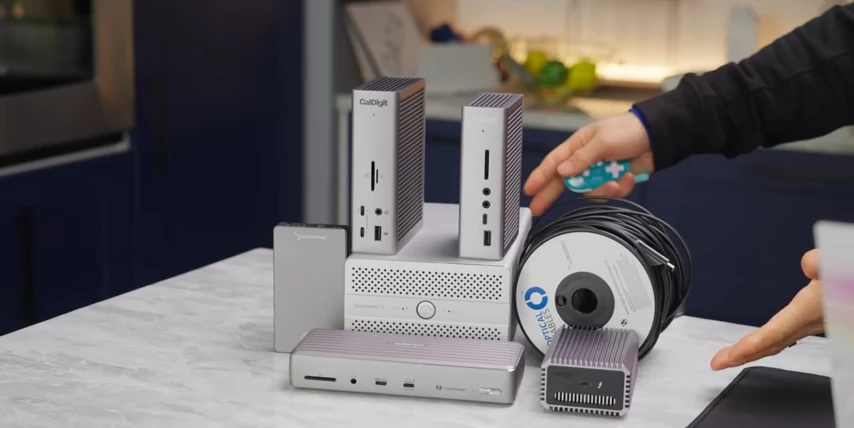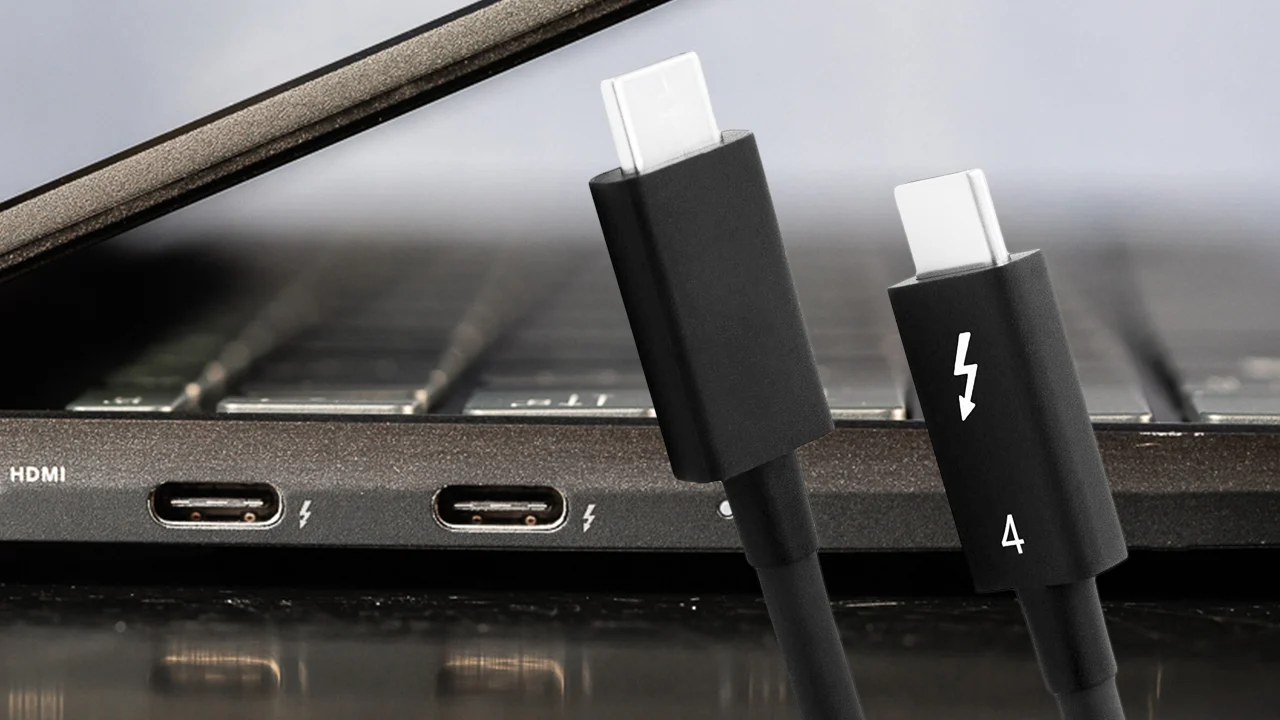USB4 is an absolute game changer. We're talking 40 gigabit per second data rates, support for 8K displays and external GPUs, single-cable docking at up to 240 watt charging rates. And all over the same USB Type-C connectors and cables that you have come to know and to... Actually, USB4 is more like a collection of optional standards.
But five years after Intel's announcement that they would open source Thunderbolt, USB4 is finally out in force and has turned out to be one of the most confusing standards ever to make it onto a consumer PC. The good news, though, is that by the time we are finished here, you will understand both its pros and cons, and how it operates or doesn't with other standards like Thunderbolt, including real-world examples.
What is USB 4?
The simple explanation really is that USB4 is an open version of Thunderbolt 3 based on the specifications that Intel released back in 2017. There is a lot to love about this move.
For one thing, it frees vendors from the shackles of Intel's notoriously onerous certification process. And for another, it allows non-intel CPU manufacturers, like Apple or especially AMD, who didn't co-develop the standard, to support features that used to be Thunderbolt exclusive, like 40-gigabit data rates, daisy-chaining together multiple devices, and PCIe tunneling, which is super cool and allows you to turn your USB-C port into a PCI-Express connection for devices like external GPUs and other add-on cards.
The problem is that when you free the notoriously cheapskate computer industry from compliance programs, you invite shortcuts. And USB4 invites a lot of shortcuts.
In no particular order, here are the optional components of the spec that can be left off of your device while still allowing the vendor to slap USB4 on the spec sheet: 40-gigabit transfer rates, 20-gigabit USB 3.2, Thunderbolt Alternate Mode, USB-C Alternate Mode, and yes, PCIe tunneling.
| Mode | Host | Hub | Peripheral device |
|---|---|---|---|
| Legacy USB (1–2) (max. 480 Mbit/s) | Yes | Yes | Yes |
| USB4 20 Gbit/s Transport | Yes | Yes | Optional |
| USB4 40 Gbit/s Transport | Optional | Yes | Optional |
| Tunneled USB 3.2 (10 Gbit/s) | Yes | Yes | Yes |
| Tunneled USB 3.2 (20 Gbit/s) | Optional | Optional | Optional |
| Tunneled Displayport | Yes | Yes | Optional |
| Tunneled PCI Express | Optional | Yes | Optional |
| Host-to-Host communications | Yes | Yes | — |
| DisplayPort Alternate Mode | Yes | Yes | Optional |
| Thunderbolt Alternate Mode | Optional | Yes | Optional |
| USB-C Alternate Modes | Optional | Optional | Optional |
In a world where almost nothing you can connect to a laptop needs the speed of even a last-gen USB3 20-gig port, isn't the whole point of USB4 PCIe tunneling and interoperability with Thunderbolt 3 devices?
Well, Microsoft sure thought so, which is why they actually require external USB4 ports on Windows 11 devices to support PCIe tunneling, which theoretically ensures backwards compatibility with Thunderbolt 3 devices. But there is no such guarantee if you were to buy a bare motherboard or a non-Windows device. And from my conversations with a device maker whose previous Thunderbolt 3 notebook actually never ended up getting certified by Intel, there's a lot more to this interoperability than just checking a box for PCIe tunneling.
Making matters even more confusing, Microsoft does not appear to have mandates in place for any of the other features. The good news is that when it works, it works really well.
Here is a small bushel of Thunderbolt 3, Thunderbolt 4, and USB4 devices that we've tried on the Voyager a1600 gaming and content creation laptop. And I'm gonna tell you guys what the experience is like on a USB4 laptop.
And I'm gonna tell you guys what the experience is like on a USB4 laptop.
Connecting TB devices to USB4 ports
For our first trick, we'll be trying to connect a couple of Thunderbolt 3 devices to our USB4 laptop. And the reason this matters is because these older devices would've been designed at a time that USB4 compatibility wouldn't have been a consideration. So if they work, it means that USB4 is transparently compatible with Thunderbolt 3.
Now, that first one I plugged in using a USB4 cable, and the second one we're gonna try an older Thunderbolt 3 cable. CalDigit 10-gig network adapter.
This backwards compatibility means that any Thunderbolt 3 device and USB4 system should work with each other. Now, I would expect to find some edge cases, particularly with very old devices, due to Intel-specific handshakes that used to be required. But we didn't run into any of them.
Now let's try a Thunderbolt 4 device. In the interest of giving ourselves our best shot here, we're gonna go ahead and use a Thunderbolt-4-validated cable. And we don't even need that old Intel application for managing all of our connected devices. I mean, I expected this to work.
The main difference between Thunderbolt 3 and Thunderbolt 4 is actually also in enforcement of compliance. So Thunderbolt 4 requires, in order to get the Intel badge, support for two 4K displays or a single 8K display. Computers must have 32 gigabit per second of PCIe bandwidth. This is to address issues folks would have with high-bandwidth devices on some Thunderbolt 3 laptops, particularly eGPUs. And they must support security improvements that protect your device from malicious connected devices. Plugable.com actually has a great writeup on the differences between Thunderbolt 3 and Thunderbolt 4.
What about speed, though? In an attempt to crack over 20 gigabit per second of transfers, we are using three separate SSDs and our network share, oh, and copying all to our boot drive at the same time. 3.6 gigabytes a second. Can confirm that we are not limited to 20 gigabit per second, even though that could be the case with USB4.
And the most mind blowing thing is that aside from some CalDigit devices that took a little while to be detected, we didn't run into any issues using Thunderbolt devices on this laptop.
MacOS vs. Windows
But there is definitely more to know here. We tested a lot of configurations and discovered not only some differences between Thunderbolt and USB4, but also between Apple's implementation and the one we found on the Corsair Voyager. See, on a Mac, two similar 5K displays, this would work. Just connect them to any Thunderbolt port you want and it works as expected. However, when we attempt to do the same thing with the Voyager, either only one display works, or if we go through a hub, we can run both of them, but they're limited to 4K resolution. Unless, we actually unplug them from our Thunderbolt ports, plug one into Thunderbolt and one into the regular USB-C 3.2 port over on the other side.
The reason for this is quite interesting. In The Verge's coverage of this laptop, Corsair's senior public relations specialist Justin Ocbina revealed that the USB4 ports are hooked up to the CPU for display. Meanwhile, the 3.2 ports are hooked up to the GPU. So they might look the same, but because they're running DisplayPort Alt Mode, they're limited to the capabilities of whichever GPU is physically attached to them. So we're able to run more than one 5K display by connecting to each of those GPUs separately. This is another really interesting example of different protocols behaving in different ways, even if they go over the same connectors.
Now, Alt Mode, what we're talking about here, uses a physical chip connected to the USB port to send a signal down that differs from standard USB. Tunneling is not the same. It converts the DisplayPort signal to packets that can be sent along a USB connection, allowing for things like data and PCIe tunnel packets to be sent alongside. So your mileage may vary depending on whether your machine uses Alt Mode or tunneled DisplayPort.
Daisy Chaining
Thunderbolt has supported multiple Thunderbolt devices daisy-chained together since the beginning. But the Wikipedia page for USB4 before explicitly says that such daisy-chaining is not supported. To clarify, you could totally plug a Thunderbolt hub into your USB4 laptop, and then a USB hub into that, and another one into that, and so on and so forth until the signal timing becomes an issue, but Intel seems to believe that connecting additional PCIe tunneling devices downstream, well, that's their jam.
Many newer Thunderbolt devices, especially hubs and docks, have controllers in them that can communicate either using Thunderbolt-like PCIe tunneling protocols or traditional USB protocols. So in many cases, it won't necessarily be obvious to you until you try to plug in another downstream device which protocol your device is using.
External GPU
Now, rather than trying to run all five of these devices, let's go for a single really demanding one: An external GPU. Our RTX 2070 external GPU. Not that we'll need to upgrade the GPU anytime soon, given that this laptop has a Radeon 6800 in it already anyway, but the point is that it does work. And the a1600 does all of this partly thanks to AMD's inclusion of USB4 on their Zen 3+ Ryzen 7000 processors. But in the absence of Intel's standards compliance team, it's also thanks to the way that Corsair has worked with their OEM to internally validate their implementation. However, watch how easily I can break things.
While Thunderbolt has used the same USB-C connector as USB devices for half a decade now, the Thunderbolt protocol, which you've heard me refer to a few times, and it's kind of like the language that's actually being spoken over the cable, well, it's closer to PCI-Express than it is to USB. So this, along with its traditionally much higher data rates, means that it has far less tolerance for latency and inconsistency, which means that cable quality matters a lot.
Is USB4 compatible with TB3/4 devices?
To answer the question, then, is USB4 compatible with Thunderbolt 3 and 4 devices? The answer is yes, but also no. The level of compatibility really is gonna come down to how good of an implementation you get. The Corsair Voyager a1600 performed admirably, but it's a machine that implements far better than the bare minimum spec, and one that doesn't go this far may not be as smooth. And as we saw today, your mileage may vary when it comes to unofficial features, like daisy-chaining and support for specialty cables like these optical ones from Corning.
The big question this raises, then, is, why did the USB-IF allow half-baked USB4 at all? Well, it seems to come down to phones. Mobile devices could get some very valid benefits from USB4, like higher data rates and DisplayPort tunneling for external devices with Samsung DeX or whatever, but they're unlikely to need the PCIe tunneling that Thunderbolt is known for, or daisy-chaining and the like.


No comments yet